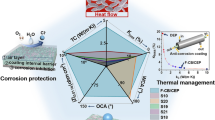Abstract
A poly-acetamide-acetoxyl methyl-propylsiloxane (PAAMPS) polymer containing a cerium (Ce) oxide-derivative was synthesized through three spontaneous reactions: condensation, amidation, and acetoxylation. The PAAMPS synthesizing took place between the Ce acetate dopant and aminopropylsilane triol (APST) as the film-forming precursor aqueous solution at 150°C. PAAMPS was evaluated for use as a corrosion-preventing coating for air-cooled condensers consisting of two metal components: aluminum fins and carbon steel tube. The key factors to ensuring the maximum performance of the PAAMPS/Ce oxide coating system in mitigating the corrosion of both aluminum and steel included (1) minimizing the content of non-reacted water-soluble APST and Ce acetate remaining in the coating, (2) lowering the susceptibility of the coating’s surface to moisture, (3) precipitating a passive Ce3+ oxide (Ce2O3) film insensitive to Cl dissolution over the metal’s surfaces, and (4) possessing excellent adhesion to the metal’s surfaces. The combination of these factors considerably decreased the rate of the cathodic oxygen reduction reaction at the corrosion site of the metals. In fact, the corrosion rate, measured in milli-inches per year (mpy), of bare steel was reduced more than one order of magnitude by applying this coating. Correspondingly, the coating extended the useful lifetime of steel exposed in a salt-fog chamber at 35°C from only ∼10 hr to ∼768 hr. Furthermore, this coating system far better protected an aluminum substrate from the corrosion than it did one of steel. Even a very thin nanoscale coating film deposited on the aluminum’s surfaces reduced the corrosion rate, (mpy), by nearly two orders of magnitude over that of the bare aluminum. Also, the salt-spray resistance of aluminum panels covered by this nanoscale film was strikingly extended to more than 1440 hr, compared with ∼40 hr for bare aluminum.
Similar content being viewed by others
References
Kutscher, C.F. and Dostenaro, D., “Assessment of Evaporative Cooling Enhancement Methods for Air-Cooled Geothermal Power Plants,”Geotherm. Resour. Counc. Trans., 26, 775 (2002).
Sugama, T., Gawlik, K., and Jung, D., “Polyaminopropylsiloxane Coatings for Geothermal Air-Cooled Condensers,”Recent Res. Devel. Mat. Sci., 4, 695 (2003).
Mansfeld, F., Breslin, C.B., Pardo, A., and Perez, F.J., “Surface Modifications of Stainless Steels: Green Technology for Corrosion Protection,”Surf. Coat. Technol., 90, 224 (1997).
Aballe, A., Bethencourt, M., Botana, F.J., and Marcos, M., “CeCl3 and LaCl3 Binary Solutions as Environment-Friendly Corrosion Inhibitors of AA5083 Al−Mg Alloy in NaCl Solutions,”J. Alloys Compd., 323, 855 (2001).
Dabala, M., Armelao, L., Buchberger, A., and Calliari, I., “Cerium-Based Conversion Layers on Aluminum Alloys,”Appl. Surf. Sci., 172, 312 (2001).
Forsyth, M., Forsyth, C.M., Wilson, K., Behrshing, T., and Deacon, G.B., “ATR Characterization of Synergistic Corrosion Inhibition of Mild Steel Surfaces by Cerium Salicylate,”Corros. Sci., 44, 2651 (2002).
Fahrenholtz, W., O’Keefe, M.J., Zhou, H., and Grant, J.T., “Characterization of Cerium-Based Conversion Coatings for Corrosion Protection of Aluminum Alloys,”Surf. Coat. Technol., 155, 208 (2002).
Yu, X. and Cao, C., “Electrochemical Study of the Corrosion Behavior of Ce Sealing of Anodized 2024 Aluminum Alloy,”Thin Solid Films, 423, 252 (2003).
Fox, H.W. and Zisman, W.A., “The Spreading of Liquids on Low Energy Surfaces. I. Polytetrafluoroethylene,”J. Colloid Sci., 5, 514 (1950).
Launer, R., “Infrared Absorption of Organosilicon Compounds: Spectras Structure Correlations,” inSilicon Compounds Register and Review, Anderson, R., Arkles, B., and Larson, G.L. (Eds.), Petrarch Systems Corp., 69, 1987.
Su, G.J., Borelli, N.F., and Miller, A.R., “An Interpretation of the Infrared Spectra of Several Glasses,”Phys. Chem. Glasses, 3, 167 (1962).
Bellamy, L.J.,The Infra-Red Spectra of Complex Molecules, Chapman & Hall, London, p. 231, 1975.
Nakanish, K. and Solomon, P.H.,Infrared Absorption Spectroscopy, Holden-Day, Inc., San Francisco, p. 15, 1977.
Toth, A., Bertoti, I., Szekely, T., Sazanov, J.N., Antonova, T.A., Shchukarev, A.V., and Gribanov, A.V., “XPS Study on the Thermal Degradation of Poly-N,N′/4,4′-Diphenylether/Pyromellitimide,”Surf. Interface. Anal., 8, 261 (1986).
Clark, D.T. and Thomas, H.R., “Applications of ESCA to Polymer Chemistry. X. Core and Valence Energy Levels of a Series of Polyacrylates,”J. Polym. Sci., 14, 1671 (1976).
Briggs, D., Brewis, D.M., and Konieczko, M.B., “X-ray Photoelectron Spectroscopy Studies of Polymer Surfaces,”J. Mater. Sci., 14, 1344 (1979).
Kasten, L.S., Grant, J.T., Grebasch, N., Voevodin, N., Arnold, F.E., and Donley, M.S., “An XPS Study of Cerium Dopants in Sol-Gel Coatings for Aluminum 2024-T3,”Surf. Coat. Technol., 140, 11 (2001).
Barreca, D., Battiston, G.A., Gerbasi, R., and Tondello, E., “Study of Cerium Dioxide Thin Films by X-ray Photoelectron Spectroscopy,”Surf. Sci. Spect., 7, 297 (2000).
Gettings, M. and Kinloch, A.J., “Surface Analysis of Polysiloxane/Metal Oxide Interfaces,”J. Mater. Sci., 12, 2511 (1977).
Bailey, R. and Castle, J.E., “XPS Study of the Adsorption of Ethoxysilanes on Iron,”J. Mater. Sci., 12, 2049 (1977).
Leung, Y.L., Yang, Y.P., Wong, P.C., Mitchell, K.A.R., and Foster, T., “X-ray Photoelectron Spectroscopic Studies with a Bias-Potential Method for Studying Silane-Aluminum Interfaces,”J. Mater. Sci. Lett., 12, 844 (1993).
Fang, J., Flinn, B.J., Leung, Y.L., Wong, P.C., Mitchell, K.A.R., and Foster, T., “A Characterization of the υ-glycidoxypropyltrimethoxysilane and Aluminum Interface by SIMS and XPS,”J. Mater. Sci. Lett., 16, 1675 (1997).
Townsend, H.E., Cleary, H.J., and Allegra, L.A., “Breakdown of Oxide Films on Steel Exposed to Chloride Solutions,”Corrosion, 37, 384 (1981).
Sterm, M. and Geary, A.L.,J. Electrochem. Soc., 104, 56 (1957).
Author information
Authors and Affiliations
Additional information
This program report, issued by the DOE Office of Geothermal Technologies, was performed under the auspices of the U.S. Department of Energy, Washington, D.C., under Contract No. DE-AC02-98CH10866.
Rights and permissions
About this article
Cite this article
Sugama, T. Cerium acetate-modified aminopropylsilane triol: A precursor of corrosion-preventing coating for aluminum-finned condensers. J Coat Technol Res 2, 649–659 (2005). https://doi.org/10.1007/BF02774594
Published:
Issue Date:
DOI: https://doi.org/10.1007/BF02774594




